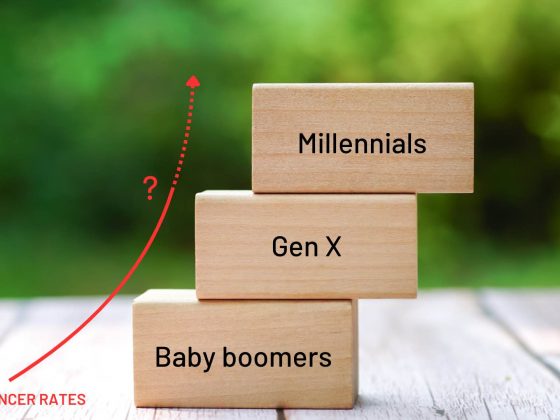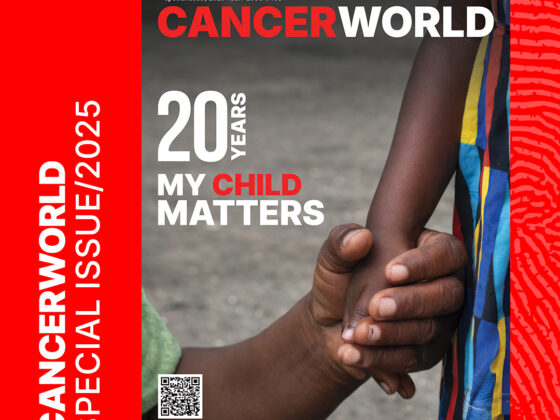‘Cancer’ is the weightiest of words. Jacky remembers the impact those two short syllables had when she was given her results after tests for breast cancer. “I went into this little room and they told me that I had cancer in situ. Now the only word I heard was cancer, and I thought, what are they saying? Cancer? What do they mean? What’s cancer in situ? And they said: ‘Oh, it’s a very early cancer, nothing terribly to worry about.’ But I was really frightened. Cancer was not in my world and, suddenly, here I was being told I had got cancer. And that was the only word I heard.”
Jacky was being told she had ductal carcinoma in situ (DCIS), like tens of thousands of other women diagnosed with the condition each year. Although DCIS can progress to invasive breast cancer, most DCIS lesions remain indolent. It is considered low risk, as are many other types of cancer that are unlikely to cause harm.
The difference between the implications of these small, low risk neoplasms and an aggressive or advanced cancer can be hugely significant. Diseases routinely referred to as ‘cancer’ vary in metastatic potential from a less than 5% chance of progression over 20 years to more than 75% chance of progression over one to two years. Yet these medical intricacies are often understandably lost on patients who hear the ‘C word’.
The impact of the words used in medicine has been charted for many years. It does not end with the emotional impact they can have on patients. It affects treatment choices and outcomes. Simply adding the word ‘disease’ to what was previously regarded as a phenomenon can cause a rush for tests and treatments.
For example, around 20 years ago doctors took to classifying what had been commonly known as chronic reflux, colic or regurgitation as ‘gastroesophageal reflux disease’ (GERD). Intrigued by the implications of this change for patients, researchers from the University of Missouri asked 275 parents to imagine that their child regularly regurgitated and cried a lot. Half the parents were told that doctors called this condition gastroesophageal reflux disease, and half were not. The result? The parents who had been told that the condition was a ‘disease’ showed considerably more interest in medicating the child – even when told the benefits of these medications were doubtful.
The results of using the word ‘cancer’ for low-risk disease might be having an even more dramatic impact. This was first raised in the 2010s, when clinicians like Canadian urological surgeons Jaimin Bhatt and Laurence Klotz drew attention to the dangers of overdiagnosis and overtreatment, and how the fear induced by the word ‘cancer’ contributed to these phenomena.
“Today, genomic tests inform our understanding of the risk and timing of recurrence, but we have yet to use them to change how we define cancer”
In 2019, a debate in the British Medical Journal asked: Should we rename low risk cancers? Breast surgeon Laura Esserman, Director of the Carol Franc Buck Breast Care Center at the University of California, San Francisco, argued that definitions need to change as knowledge progresses.
“In the past, it was not possible to reliably identify lesions with negligible risk,” she said. “Today, genomic tests inform our understanding of the risk and timing of recurrence, but we have yet to use them to change how we define cancer.”
Against her stood histopathologist Murali Varma, who argued that alternative names could be confusing, and that better education was the answer. Those contrasting opinions highlighted the twists and turns of a debate, conducted mainly in the fields of breast, prostate and thyroid cancer, which continues to simmer.
Prostate: ‘cancer’ or ‘pre-cancer’?
Two years ago, a group of urologists, radiation oncologists, pathologists and patient advocates from North America proposed that low grade prostate cancer – Gleason score 6 (GS6) – should be regarded as pre-cancer rather than cancer, and renamed as such. Fewer than 1% of men with GS6 tumours experience metastatic disease or die from cancer within 15 years of initial diagnosis. Under the title ‘Low-Grade Prostate Cancer: Time to Stop Calling it Cancer’, lead author Scott Eggener, a urologic oncologist and professor of surgery at the University of Chicago, pointed out that using the term ‘cancer’ to describe this low-risk condition induces unwarranted fears and influences decision-making.
“No matter how much time a physician may spend downplaying the significance of a GS6 diagnosis or emphasizing the phrase low-risk, the words ‘you have cancer’ have a potent psychological effect on most men and their families,” he wrote.
That effect is likely to make many opt for radical treatments to rid themselves of cancer, even though those treatments may lead to reduced quality of life and regrets. Half of men who have surgery or radiotherapy for prostate cancer say it causes problems with sexual functioning, and 20% say they have problematic urinary leakage after surgery.
Reclassifying such growths as non-cancerous, he said, would immediately address the issue of overtreating cancers that are never likely to be life-threatening. It would mean fewer men receiving unnecessary radiation and surgery, fewer experiencing treatment-related side effects, lower patient and family anxiety and a reduction in the financial burden to families and healthcare providers.
There are many – notably pathologists – who disagree with this stance. At this year’s European Association of Urology Congress in Paris, Eva Compérat, a leading pathologist in genito-urinary cancers, took issue with urologists who want to see more emphasis on active surveillance for low-risk prostate cancers and believe reclassifying GS6 would help.
“Yes, it is true that these tumours rarely have metastases, they have good outcomes, and they are not very aggressive,” said Compérat, who is head of the Pathology Department at Tenon Hospital, Sorbonne University, in Paris. “It is true that patients are anxious and there is the danger of overtreatment.”
“However, first there is the problem of underestimating. If you have done a biopsy, are you absolutely sure there is not a focus of higher grade in there too? And the second problem is that, even if you have a Gleason score of 6, there is still the molecular underpinnings of cancer.”
“If you have done a biopsy, are you absolutely sure there is not a focus of higher grade in there too?”
She pointed to studies showing that 15 years after diagnosis, even people with GS6 prostate cancers die. A lot depends on the molecular signature of the cancer. “Gleason 6 is cancer. I’m sorry to say, mortality exists.”
But if debate still bubbles around whether prostate cancers should be reclassified, the battle lines are not entirely clearly drawn. While some prostate cancer patients and their advocacy groups are concerned that the classification of cancer is too broad, affecting insurance availability and premiums for men with low-risk disease, others oppose a change. It could make men complacent, they say, and result in undertreatment and many dropping out of active surveillance programmes.
A survey of 450 prostate cancer patients presented to the American Society of Clinical Oncology (ASCO) Genitourinary Cancers Symposium by a consortium of patient groups in 2023 showed how divided patients are: 35% supported reclassifying Gleason 6 as a non-cancer and 35% opposed it, with 30% undecided.
Thyroid: ‘cancer’ or ‘nodule’?
Opinion is also divided in the field of thyroid cancers, where the issues surrounding re-labelling low-risk tumours parallel those in prostate cancer. In high-income countries, rates of thyroid cancer have been rocketing since the 1990s due to growing scrutiny of the thyroid gland with ultrasonography and other diagnostic techniques, which can pick up the smallest of lesions. Most small thyroid cancers, for example papillary thyroid cancers, have an excellent prognosis and a low risk for recurrence and spread outside the thyroid – so surgery is not normally necessary, and guidelines recommend active surveillance. Yet studies have indicated a significant increase in thyroidectomies without clear benefit for the patient.
“Whether a growth was labelled a ‘cancer’, ‘nodule’ or ‘tumour’ had a considerable influence on perceptions of the risk”
Is using the word ‘cancer’ for these lesions influencing the unnecessarily high rates of surgery? Researchers from the University of Toronto think that it is. They asked whether the label given to a thyroid neoplasm could play a role in decision-making. In a survey of 1,214 people, they found that whether a growth was labelled a ‘cancer’, ‘nodule’ or ‘tumour’ had a considerable influence on people’s perceptions of the risk of progression and recurrence. Participants were willing to accept a 4 percentage point increased risk of progression or recurrence (from 1%–5%) to avoid their disease being labelled a ‘cancer’ as opposed to a ‘nodule’.
“The cancer disease label may lead to overtreatment of low-risk malignant neoplasms owing to a patient’s emotional response or misunderstanding of prognosis,” said lead author Peter Dixon, from the Department of Otolaryngology at the Institute of Health Policy, Management and Evaluation, Toronto.
Yet, as in prostate cancer, not everyone agrees. In 2020, Australian researchers involved members of the public in focus groups considering a terminology change for small low-risk papillary thyroid cancer. Over two days of expert presentations and discussion, the participants voted on whether to keep the word ‘cancer’ – but ultimately their opinions were split down the middle, with many changing their minds over the course of the event.
All the participants, however, agreed that there should be increased education for patients and the public on the issues involved, and that health professionals had a responsibility to reduce the harms of overtreatment.
DCIS: ‘breast cancer’ or ‘high-risk condition’?
In breast cancer, proposals to re-classify DCIS as non-cancerous emerged in the 2010s alongside increasing concerns about overdiagnosis and overtreatment. In 2014, breast surgeons and oncologists from the University of Washington reported that DCIS now accounted for nearly 22% of new breast cancer diagnoses, with up to 30% being treated with mastectomy. This was in the face of evidence that as few as 20% of DCIS cases might progress to invasive cancer over a protracted period of 5 to 40 years.
At the same time, researchers from the Massachusetts General Hospital conducted a survey of 394 healthy women without breast cancer, who were asked how they would proceed with treatment, depending on the terms used to describe DCIS. When DCIS was described as a ‘high-risk condition’ instead of a cancer, 65% of women opted for nonsurgical treatments such as active surveillance. When it was described as ‘non-invasive cancer’ only 53% opted for those less radical treatments.
Was this an argument for reclassifying DCIS as a ‘high-risk marker’ rather than a ‘cancer’? Contemporary commentators were wary. “Although we agree that a subset of patients with DCIS is being overtreated with the current therapy paradigms,” wrote a University of Washington team, “we also feel strongly that a broad, sweeping change in terminology is premature, because such a change would overlook the biological diversity of DCIS, from which at least 20% to 40% of cases will progress to invasive cancer if not properly managed.”
“Most patients who die of breast cancer following a DCIS diagnosis die from recurrences often not genetically related to the original lesion”
But the debate continued. In October 2022, Laura Esserman chaired a special conference held by the American Association for Cancer Research (AACR) to consider whether DCIS should be considered a cancer. Jennifer Marti, an assistant professor of surgery at Weill Cornell Medical College, argued that DCIS did not follow most normal definitions of cancer: the majority of patients who die of breast cancer following a DCIS diagnosis die from invasive recurrences often not genetically related to the original DCIS lesion, she said.
She pointed out that risk of DCIS progression increases by 1–2% a year, similar to other breast neoplasia such as atypical ductal hyperplasia, atypical lobular hyperplasia and lobular carcinoma in situ – growths that are not classed as cancers and are not treated as vigorously as DCIS (possibly due to their classification).
Renaming DCIS could therefore decrease overtreatment. “When you call it cancer, you’ll treat it as an aggressive cancer,” concluded Marti. “If you do a surgery like this, are you helping your patient live longer or live better?”
On the opposite side, Steven Narod, a senior scientist at the Women’s College Research Institute in Toronto, said that researchers had observed circulating tumour cells, positive lymph nodes, and tiny bone micro-metastases in DCIS patients with no evidence of tumour invasion. “If a DCIS can metastasize, then that’s cancer,” he said, arguing that cancer itself would need to be redefined if conditions such as DCIS were reclassified. Others at the event pointed out that a sudden change in classification might result in confusion and mistrust from patients.
Nevertheless, last year saw new data which added further weight to the arguments for reclassification. A review of evidence published in Breast Cancer Research and Treatments found that women with low-grade DCIS have comparable outcomes whether or not they have surgery. It concluded that “epidemiological evidence supports consideration of relabelling and/or recalibrating diagnostic thresholds for low-risk DCIS.”
The way forward: reclassification or education?
Opponents of reclassification cite many risks: underestimating the malignant potential of disease, the upheaval and administrative complication of reclassifying, confusion among patients. But concerns about impracticability are to some extent met by the fact that, in one instance, a reclassification of a cancer to a non-cancer has already happened. And, according to some, it has been very successful.
In 2016, one particular variant of papillary thyroid cancer (EFVPTC) was reclassified by a panel of experts to ‘non-invasive follicular thyroid neoplasm with papillary-like features’ (NIFTP). This removal of the word ‘cancer’ from its title followed many years of mounting evidence that the growth was very indolent. According to Yuri Nikiforov, Professor of Pathology at the University of Pittsburgh Medical Center, who headed the review panel, the result of reclassification has been a shift away from aggressive treatment. No further surgery is now required following biopsy, with surveillance taking place for one to two years.
“We now have molecular markers that can predict with high degree of confidence when we are dealing with these low-risk tumours, NIFTP or low-risk, and this may help us not overtreat patients,” said Nikiforov. “If a diagnosis of NIFTP is rendered, no additional treatments are needed.”
Indeed, advances in molecular technologies and predictive artificial intelligence are likely to put many classifications in oncology on shifting sands in the coming years. At the AACR special conference on reclassifying DCIS, delegates agreed on the need for strong biomarkers to better predict progression and differentiate the ‘cancerous’ from the ‘noncancerous’.
Breast surgeon Laura Esserman, one of the strongest advocates of DCIS reclassification, was hopeful that there would be more clarity on these issues soon. “I am certain that there will be artificial intelligence capabilities to look at pathology slides to tell you what is in that more indolent biology,” she said.
“One of the best antidotes to patient anxiety and patient overtreatment is an informed patient”
For the time being, however, and while patient opinion remains so divided, the answer may be to fall back on the principles that should pervade every patient consultation anyway: clear explanation and good communication. One of the best antidotes to patient anxiety and patient overtreatment is an informed patient.
That’s certainly the belief of Tom Hope, who received a prostate cancer diagnosis in 2009 at the age of 62. It was low-grade prostate cancer, and after much discussion with his doctors, he decided to pursue active surveillance. He is still in good health.
“I have followed the debate in journals and webinars whether we should stop calling low grade prostate cancers such as mine ‘cancer’,” he says. “My own view is that this will not remove the shock and worry of going through the prostate cancer diagnostic process. I believe the best way forward is to explain to men who are undergoing diagnosis that there is scientific evidence that 80% of men at 80 will have prostate cancer and it will not cause them a medical problem or kill them.”
“I believe it will be more successful to offer reassurance to the men and their families about the low risk of serious prostate cancer than to tell them it is not cancer.”
The challenge for clinicians, as ever, is to prioritise the kind of detailed and compassionate communication that will undoubtedly provide patients with reassurance, and ultimately improve their quality of life.
Illustration by Maddalena Carrai












